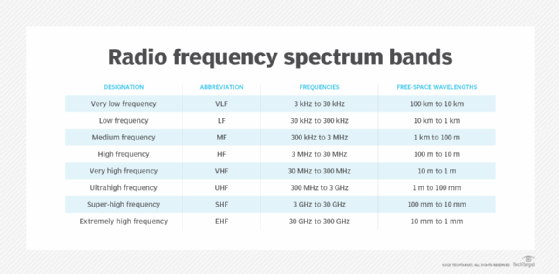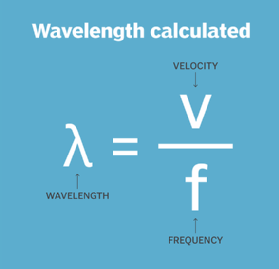frequency band
What is a frequency band?
In telecommunications, a frequency band -- sometimes called a band -- refers to a specific range of frequencies in the electromagnetic frequency spectrum assigned to certain applications. This spectrum is divided among ranges from very low frequencies (VLF) to tremendously high frequencies (THF). Each frequency band has a defined upper and lower frequency limit.
A frequency band is simply the range or interval of radio frequencies used to transmit a signal over a telecom network. All bands -- of which there are many -- are identified by their lower and upper limits. All these various frequency bands are part of the overall electromagnetic spectrum. The energy transmitted over electromagnetic waves is regulated based on frequency bands.

Different frequency bands are allocated for wireless signal transmission for different applications. This enables these various bands to coexist and various applications to use the bands without chaos. For example, both cellphones and car radios send wireless signals over the available electromagnetic spectrum. However, they do so over different frequency bands so neither are affected by interference and can continue to operate the way they are supposed to.

Designating frequency bands
The electromagnetic spectrum is a set of possible frequency bands or electromagnetic radiations available for various real-world wireless applications. These bands are arranged in ascending order of frequency -- lowest to highest measured in multiples of Hertz -- and named for their frequency limits -- upper and lower -- wavelength. Also, frequency and wavelength are inversely related, meaning the higher the frequency, the lower its wavelength.
Each frequency band, typically identified by megahertz (MHz) rating, is assigned a number by the International Telecommunication Union (ITU). The spectrum starts from ITU band number 1, which is assigned to the frequency band named extremely low frequency (ELF) and goes all the way to ITU band number 12, which is assigned to the terahertz or tremendously high frequency (THF) frequency band.
The various frequency bands in the electromagnetic spectrum and their names (as per ITU naming convention) are as follows:
| Frequency band | ITU band number | Frequency limits (lower to upper) | Wavelength (meters) |
| Extremely low frequency (ELF) | 1 | 3 to 30 hertz (Hz) | 10,000 to 100,000 kilometers (km) |
| Super low frequency (SLF) | 2 | 30 to 300 Hz | 1,000 to 10,000 km |
| Ultra low frequency (ULF) | 3 | 300 Hz to 3 kilohertz (kHz) | 100 to 1,000 km |
| Very low frequency (VLF) | 4 | 3 to 30 kHz | 10 to 100 km |
| Low frequency (LF) | 5 | 30 to 300 kHz | 1 to 10 km |
| Medium frequency (MF) | 6 | 300 kHz to 3 MHz | 100 to 1,000 meters (m) |
| High frequency (HF) Also known as shortwave radio or decameter band |
7 | 3 to 30 MHz | 10 to 100 m |
| Very high frequency (VHF) | 8 | 30 to 300 MHz | 1 to 10 m |
| Ultra high frequency (UHF) | 9 | 300 MHz to 3 gigahertz (GHz) | 10 to 100 centimeters (cm) |
| Super high frequency (SHF) Also known as centimeter band |
10 | 3 to 30 GHz | 1 to 10 cm |
| Extremely high frequency (EHF) Also known as the millimeter band |
11 | 30 to 300 GHz | 1 to 10 millimeters (mm) |
| Terahertz or tremendously high frequency (THF) Also known as the submillimeter band |
12 | 300 GHz to 3 terahertz (THz) | Less than 10 mm |
The electromagnetic spectrum consists of many subranges of frequency bands, such as radio waves, microwaves, X-rays, infrared rays and gamma rays. Each subrange falls under a specific frequency band.
The ITU helps regulate the transmission of frequency bands along with any regulatory laws of the country in which they're used. For example, domestic use of the radio spectrum is regulated by national agencies such as the Federal Communications Commission (FCC) in the U.S. Regulatory organizations assign each transmission source a band of operation, a transmitter radiation pattern and a maximum transmitter power. The Institute of Electrical and Electronics Engineers (IEEE) also contributes to frequency band designation and is responsible for designating bands used for radar, terrestrial and satellite applications.
Frequency band applications
The various applications of each frequency band are as follows:
| Frequency band | Applications and uses |
| Extremely low frequency |
|
| Super low frequency |
|
| Ultra low frequency |
|
| Very low frequency |
|
| Low frequency |
|
| Medium frequency |
|
| High frequency |
|
| Very high frequency |
|
| Ultra high frequency | |
| Super high frequency |
|
| Extremely high frequency |
|
| Terahertz or tremendously high frequency |
|
More on the THF frequency band
Waves in the THF frequency band are known as terahertz waves, T-waves or T-rays. The upper limit is usually 3,000 GHz or 3 THz (1 THz = 1,000 GHz) although some sources designate it as 30 THz. Terahertz radiation begins at a wavelength of around a millimeter and proceeds into shorter wavelengths.
T-waves can penetrate thin layers of many non-conducting materials, such as paper, wood, clothing, plastic and ceramics, which makes them suitable for producing high-res images of the interiors of solid objects. The rays can also penetrate through the human body, and therefore provide an alternative to X-rays. That said, T-rays have a longer wavelength than X-rays so they provide lower-resolution images than X-rays. In the air, T-waves are attenuated to zero within just a few meters, which is why they are unsuitable for terrestrial radio communication.
Learn more about wireless frequency bands, including the difference between licensed and unlicensed bands.






